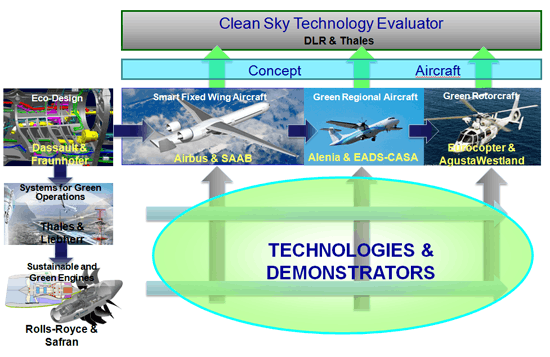Clean Sky
Clean Sky Joint Undertaking is the largest aeronautical research programme ever launched in Europe for the development of breakthrough technologies integrated to significantly increase the environmental performances of aeroplanes and air transport, resulting in quieter and more fuel efficient aircraft, hence bringing a key contribution in achieving the Single European Sky environmental objectives.
The objectives of this programme are, by 2020, to reduce:
- CO2 emissions by 50%
- NOx emissions by 80%
- Noise perception by 50%
Overview
Clean Sky mission is to progress breakthrough technologies and refined aerodynamic techniques to the testing and implementation stages for project realisation and handover into production.
The Clean Sky JTI (Joint Technology Initiative) was born in 2008 and represents a unique Public-Private Partnership between the European Commission and the industry. It is managed by the Clean Sky Joint Undertaking (CSJU) until 31 December 2017.
The CSJU will deliver demonstrators in all segments of civil air transport, grouped into six technological areas called 'Integrated Technology Demonstrators' (ITD)

Funding and budget
Clean Sky has an overall budget of € 1.6 billion, contributed to on a 50/50 basis by the European Commission (in cash) and the aeronautical industry (in-kind contribution). ITD Leaders commit up to 50%, Associates members up to 25% and Partners (through Call for Proposals) a minimum of 25%.
Members
Clean Sky was created in 2008 by the European Union and 12 industry leaders that commit financially for the entire duration of the CSJU:
- EADS
- GKN
- SITEC
- RUAG
- Airbus
- Airbus Helicopters (formally Eurocopter)
- Fraunhofer
- Alenia Aeronautica
- AgustaWestland
- Safran
- Thales
- Saab
- Dassault Aviation
- Liebherr
- Rolls-Royce
Programme
Clean Sky is made up of 6 Integrated Technology Demonstrators.
- Smart Fixed Wing Aircraft (Breakthrough Laminar Aircraft Demonstrator in Europe) will deliver active wing technologies and new aircraft configuration for breakthrough, news products.
- Green Regional Aircraft will deliver low-weight aircraft using smart structures, as well as low external noise configurations and the integration of technology developed in other ITD's, such as engines, energy management and new system architectures.
- Green Rotorcraft will deliver innovative rotor blades and engine installation for noise reduction, lower airframe drag, integration of diesel engine technology and advanced electrical systems for elimination of noxious hydraulic fluids and fuel consumption reduction.
- Sustainable and Green Engines will design and build five engine demonstrators to integrate technologies for low noise and lightweight low pressure systems, high efficiency, low NOx and low weight cores and novel configurations such as open rotors and intercoolers.
- Systems for Green Operations will focus on all-electrical aircraft equipment and systems architectures, thermal management, capabilities for "green" trajectories and mission and improved ground operations to give any aircraft the capability to fully exploit the benefits of Single European Sky.
- Eco-Design will focus on green design and production, withdrawal, and recycling of aircraft, by optimal use of raw materials and energies thus improving the environmental impact of the whole products life cycle and accelerating compliance with the REACH directive.
- A simulation network called the Technology Evaluator will assess the performance of the technologies thus developed.
Demonstrators
Real life demonstrations are essential components of the Programme as they will enable technologies to reach a high level of maturity. This in turn will be essential in order to assess the environmental improvements that are achievable. The following technologies will be demonstrated within the 2013-2016 timeframe:
- Contra Rotating Open Rotor (CROR) Demo Engine Flying Test Bed
- High Speed Demonstrator for passive laminar-fl ow wing technologies
- Low Speed Demonstrator for advanced control surfaces for high lift
- Regional Aircraft Integrated Flight Test Demonstration
- Regional Aircraft Static & Fatigue Full Scale Ground Demonstration
- Regional Aircraft Large Scale Wind Tunnel Test
- Rotorcraft lift & drag demonstrators
- Diesel engine demonstrator for light helicopters
- Aircraft & Rotocraft Systems Demonstrators
- Geared Open Rotor Demonstrators
- Large Three-shaft Engine Demonstrator
- Advanced Geared Turbofan Demonstrator
- Advanced Turboshaft Demonstrator
Clean Sky JU staff
The Clean Sky Joint Undertaking is composed of around 30 staff, the executive director is Eric Dautriat
References
External links
- Clean Sky JU web site
- Single European Sky
- ACARE - Advisory Council for Aeronautics Research in Europe
Related Subjects
- FAR - Federal Aviation Regulations
- Royal Aeronautical Society
- WEMMA - West of England Metals and Materials Association
- WES - Women's Engineering Society
- The Helicopter Museum (Weston-Super-Mare, UK)
- IET - Institute of Engineering and Technology
- CAD - Computer Aided Design
- Stress Analysis and Simulation Software